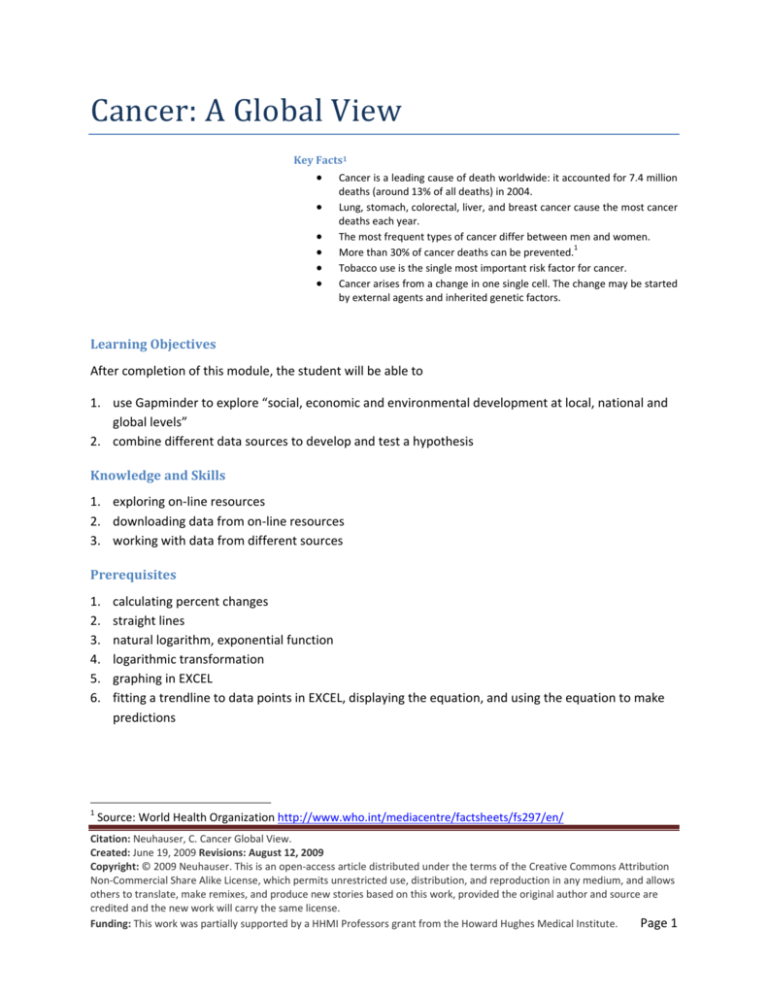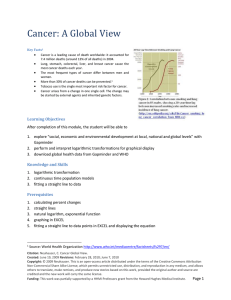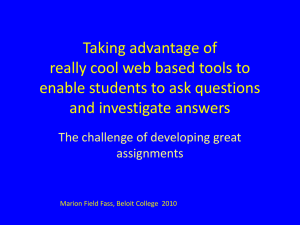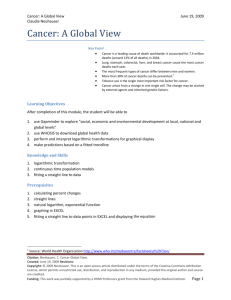Cancer: A Global View
advertisement

Cancer: A Global View Key Facts1 • • • • • • Cancer is a leading cause of death worldwide: it accounted for 7.4 million deaths (around 13% of all deaths) in 2004. Lung, stomach, colorectal, liver, and breast cancer cause the most cancer deaths each year. The most frequent types of cancer differ between men and women. More than 30% of cancer deaths can be prevented.1 Tobacco use is the single most important risk factor for cancer. Cancer arises from a change in one single cell. The change may be started by external agents and inherited genetic factors. Learning Objectives After completion of this module, the student will be able to 1. use Gapminder to explore “social, economic and environmental development at local, national and global levels” 2. combine different data sources to develop and test a hypothesis Knowledge and Skills 1. exploring on‐line resources 2. downloading data from on‐line resources 3. working with data from different sources Prerequisites 1. 2. 3. 4. 5. 6. calculating percent changes straight lines natural logarithm, exponential function logarithmic transformation graphing in EXCEL fitting a trendline to data points in EXCEL, displaying the equation, and using the equation to make predictions 1 Source: World Health Organization http://www.who.int/mediacentre/factsheets/fs297/en/ Citation: Neuhauser, C. Cancer Global View. Created: June 19, 2009 Revisions: August 12, 2009 Copyright: © 2009 Neuhauser. This is an open‐access article distributed under the terms of the Creative Commons Attribution Non‐Commercial Share Alike License, which permits unrestricted use, distribution, and reproduction in any medium, and allows others to translate, make remixes, and produce new stories based on this work, provided the original author and source are credited and the new work will carry the same license. Page 1 Funding: This work was partially supported by a HHMI Professors grant from the Howard Hughes Medical Institute. Gapminder Gapminder (http://www.gapminder.org/) “is a non‐profit venture promoting sustainable global development and achievement of the United Nations Millennium Development Goals by increased use and understanding of statistics and other information about social, economic and environmental development at local, national and global levels.” (http://www.gapminder.org/about‐gapminder/) In‐class Activity 1 (All) Watch the following video in Gapminder: http://www.gapminder.org/videos/lung‐cancer‐statistics/ Based on the graph that displayed lung cancer rates in men versus women, the speaker concluded that lung cancer is “mostly a disease of men.” What characteristic of the graph supports this claim. In‐class Activity 2 (Individual Work) Go to Gapminder (http://www.gapminder.org/). To get a sense for how various variables depend on population size, explore Gapminder World: Display Income per capita (GDP/ capita, inflation‐adjusted $) on the horizontal axis and the following secondary variables on the vertical axis. • • Health > Cancer, lung > Lung cancer, new cases per 100,000 men Health > Cancer, lung > Lung cancer, new cases per 100,000 women Circles of different colors and sizes are shown in the graph. Explain what the size and the color of a circle means. Use the Play button to see how each of the variables changes over time. Hold your cursor over geographic regions. Explore what happens when you change the axes from lin to log. Citation: Neuhauser, C. Cancer Global View. Created: June 19, 2009 Revisions: August 12, 2009 Copyright: © 2009 Neuhauser. This is an open‐access article distributed under the terms of the Creative Commons Attribution Non‐Commercial Share Alike License, which permits unrestricted use, distribution, and reproduction in any medium, and allows others to translate, make remixes, and produce new stories based on this work, provided the original author and source are credited and the new work will carry the same license. Page 2 Funding: This work was partially supported by a HHMI Professors grant from the Howard Hughes Medical Institute. Figure 1: Screenshot of Gapminder to explore Gapminder Homework 1 (Individual or Group Work) (a) To download data from Gapminder, go to List of indicators and download the “indicator list” to excel. The 4th tab (Indicators) lists all indicators for which Gapminder has data. To download a specific indicator, click on the appropriate cell in Column E (Indicator url). You can then download the data to a spreadsheet. Download the data for lung cancer, new cases per 100,000 men, and plot the data for Finland as a function of year. (b) Identify a question that you would like to investigate with the data provided by Gapminder. Download the appropriate data and explore. Write a one‐page report that starts with the question you want to explore, followed by the approach you would take to explore the question, and insert a graph that illustrates your approach. (If you work in groups, each group member must write up their own report.) Figure 2: Screenshot of Gapminder to download data Citation: Neuhauser, C. Cancer Global View. Created: June 19, 2009 Revisions: August 12, 2009 Copyright: © 2009 Neuhauser. This is an open‐access article distributed under the terms of the Creative Commons Attribution Non‐Commercial Share Alike License, which permits unrestricted use, distribution, and reproduction in any medium, and allows others to translate, make remixes, and produce new stories based on this work, provided the original author and source are credited and the new work will carry the same license. Page 3 Funding: This work was partially supported by a HHMI Professors grant from the Howard Hughes Medical Institute. Tobacco, GDP, and Lung Cancer Tobacco has been implicated as a major risk factor for lung cancer. The Center for Disease Control and Prevention states that “in the United States, about 90% of lung cancer deaths in men and almost 80% of lung cancer deaths in women are due to smoking. People who smoke are 10 o 20 times more likely to get lung cancer or die from lung cancer than people who do not smoke.”2 Up to 40% of newly diagnosed lung cancers occur in former smokers (median abstinence duration 9 year)3. In‐class Activity 3 (Group Work) We can ask the question whether the price of tobacco products affect lung cancer rates. A mashup of data from the CDC, World Health Organization (WHO), and Gapminder provides data for select countries on the following three indicators: (1) price of 100 packs of cigarettes as a percentage of GDP per capita, (2) the per capita GDP for select years, and (3) lung cancer rates in men and women for a single year. (See the data in the spreadsheet called MashupCigarettesGDPCancer.) Develop a hypothesis on how the three indicators might be related. Use the data to investigate the relationship between the three indicators. Your group should prepare a power point presentation that includes your group’s hypothesis, appropriate graphs, and your group’s conclusion. Homework 2 (Individual Work) The data set in In‐class Activity 3 is missing data from the United States. (a) Find the U.S. per capita GDP for a recent year and the price of cigarettes. (b) Calculate the Price of 100 packs of cigarettes as a percentage of GDP per capita and predict the number new lung cancer cases per 100,000 male population. (c) Based on the trendlines you found in In‐class Activity 3, how much would a pack of cigarettes need to cost to reduce new lung cancer cases to about half of what they currently are? (d) In a one half‐page report, critique the approach in (c). 2 3 Source: http://www.cdc.gov/cancer/lung/basic_info/risk_factors.htm Source: http://www.chestx‐ray.com/Smoke/Smoke.html Citation: Neuhauser, C. Cancer Global View. Created: June 19, 2009 Revisions: August 12, 2009 Copyright: © 2009 Neuhauser. This is an open‐access article distributed under the terms of the Creative Commons Attribution Non‐Commercial Share Alike License, which permits unrestricted use, distribution, and reproduction in any medium, and allows others to translate, make remixes, and produce new stories based on this work, provided the original author and source are credited and the new work will carry the same license. Page 4 Funding: This work was partially supported by a HHMI Professors grant from the Howard Hughes Medical Institute.









